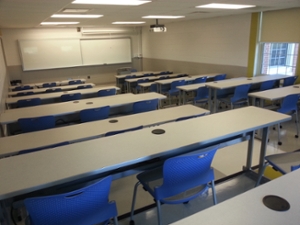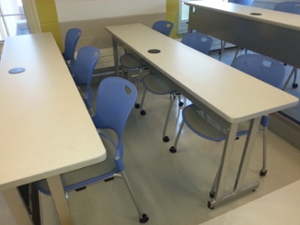Classrooms that facilitate student learning
Current research on the effectiveness of learning spaces tends to focus on three main ways of learning (AMA, 1):
- By reflection (quiet, private places for individual work, with access to a wide range of learning resources)
- By doing (labs, learning commons, etc.)
- By conversation (reconfigurable classroom furniture to facilitate group work, cyber cafés, department lounges, group rooms in libraries, etc.)
Classroom characteristics that are very important for creating effective educational spaces include comfort, the presence of natural light, windows that can be opened, nice views out the windows, decent quality furniture, and power sources for laptops and mobile device recharging (AMA, 16). Other relevant factors are adjustable lighting (ability to dim the room sufficiently so as to not wash out images projected on screens, but not so dark as to interfere with note taking and other class work); temperature, air quality, noise levels (both acoustic dampening when noisy active learning methods are used and susceptibility to spillover noise from outside); the ability of the instructor to circulate around the room; and room equipment (e.g., blackboards, white boards, smart boards, projection screens, digital cameras and projection screens, document project, universal design for accessibility of students with disabilities).
How these features are implemented at UNB
By winter term 2015, 20 UNB classrooms will be equipped with wireless presentation systems. This means the instructor can display photographs and documents from her or his mobile device or laptop on the classroom presentation screen without plugging in anything. Also, the instructor will be able to have students display what’s on their mobile device, one at a time. (Ask for a “wireless presentation room.”)
Instructors using active learning techniques that require students to have individual internet access can be assured that every classroom on campus will have the required capacity for the number of simultaneous wireless network logins required.
As classrooms are being renovated, they are being equipped with electrical outlets for students to plug in their laptops and mobile devices for recharging. Fixed seating classes have been upgraded to 1:1 or 2:1 student-to-electrical-outlet ratios when renovated.
There have been 9 classroom renovations in the last 3 years that have provided flexible configuration of chairs and tables. As a general rule, the more flexible the classroom furniture, the fewer power outlets available to students. However, flexible configuration considerably improves the group work environment. See ongoing classroom renovation for information updates.
Even as fixed configuration classrooms are being renovated, design changes facilitate group work. When renovating a typical 30-50 seat, long and narrow room with elevated seating, two rows of fixed tables are put on one level, and the chairs can be turned around (or swivel if attached), making it possible for students in each set of two rows to work in groups at eye level to each other while seated. An example of this is Tilley 304:


If you are looking for a particular kind of room for your class, or would like to know the features of the classroom you have been assigned, contact Classroom Services at 458-7662 and classrooms@unb.ca (See Classroom Services for more information.)
See the principles guiding UNB classroom design based on the National Survey of Student Engagement research-based indicators and, see implications for classroom design for these indicators.
See process of classroom design for renovating classrooms, which involves gathering a lot of feedback from instructors and students.
See Videoconferencing for classes, meetings, and a smaller room for graduate research for booking.
Where’s the evidence?
Is there any evidence that classroom characteristics that facilitate active learning actually improve student performance? In one study at the University of Minnesota involving 169 students in two sections of a first-year Principles of Biological Science course, the answer is yes. The course had two sections, the same instructor, different classrooms—one conventional, one technologically enhanced and conducive to active learning techniques (an Active Learning Classroom, ALC). Both met in the same 8:15–9:55 a.m. time slot with the traditional class meeting on Mondays and Wednesdays and the ALC class meeting on Tuesdays and Thursdays. The ALC students earned an average of 29.81 more points than expected (according to outcomes predicted by their American College Testing scores coming into the course, apparently a widely-used performance calculation method in the US) (Brooks, 723).
The University of Minnesota ALC (one of two) features large, round tables that can seat up to nine students each; the ability to project student laptop content onto a flat panel display for each round table; an instructor station from which content can be displayed on two large projector screens as well as being fed to the student display screens; and wall-mounted glass marker boards around the room perimeter (Brooks, 721).
Both students and faculty considered the ALCs useful for changing the way in which learning occurred, changing the nature of student-instructor interaction. The round tables were most frequently cited as the most important feature because they lent themselves to a greater use of collaborative and student-centred learning activities (Brooks, 721).
References
AMA Alexi Marmot Associates in association with haa design. (2006). Spaces for learning a review of learning spaces in further and higher education. A report for the Scottish Funding Council.
Brooks, D. C. (2010). Space matters: The impact of formal learning environments on student learning. British Journal of Educational Technology, 42(5).
JISC. Designing Spaces for Effective Learning: A Guide to 21st Century Learning Space Design.
MacPhee, L. (2009). Learning Spaces: A Tutorial. EDUCAUSE Review Online.
